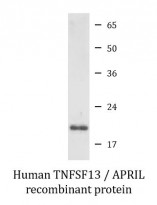ARG70084
Human TNFSF13 / APRIL recombinant protein (Active) (His-tagged, C-ter)
Human TNFSF13 / APRIL recombinant protein (Active) (His-tagged, C-ter) for SDS-PAGE
Overview
| Product Description | E. coli expressed, His-tagged (C-ter) Active Human TNFSF13 / APRIL recombinant protein |
|---|---|
| Tested Application | SDS-PAGE |
| Target Name | TNFSF13 / APRIL |
| Species | Human |
| A.A. Sequence | Ala1 - Leu146 |
| Expression System | E. coli |
| Activity | Active |
| Activity Note | Determinedd by its ability to induce cell death in Jurkat cells. The ED50 for this effect is 2.6-4.0 μg/mL. |
| Alternate Names | TALL2; ZTNF2; TRDL-1; TNF- and APOL-related leukocyte expressed ligand 2; CD256; APRIL; A proliferation-inducing ligand; TNF-related death ligand 1; UNQ383/PRO715; CD antigen CD256; Tumor necrosis factor ligand superfamily member 13; TALL-2 |
Properties
| Form | Powder |
|---|---|
| Purification Note | Endotoxin level is less than 0.1 EU/µg of the protein, as determined by the LAL test. |
| Purity | > 98% (by SDS-PAGE) |
| Buffer | PBS containing 0.1% sarkosyl (pH 8.0) |
| Reconstitution | It is recommended to reconstitute the lyophilized protein in sterile water to a concentration not less than 200 μg/mL and incubate the stock solution for at least 20 min at room temperature to make sure the protein is dissolved completely. |
| Storage Instruction | For long term, lyophilized protein should be stored at -20°C or -80°C. After reconstitution, aliquot and store at -20°C or -80°C for up to one month. Storage in frost free freezers is not recommended. Avoid repeated freeze/thaw cycles. Suggest spin the vial prior to opening. |
| Note | For laboratory research only, not for drug, diagnostic or other use. |
Bioinformation
| Gene Symbol | TNFSF13 |
|---|---|
| Gene Full Name | tumor necrosis factor (ligand) superfamily, member 13 |
| Background | The protein encoded by this gene is a member of the tumor necrosis factor (TNF) ligand family. This protein is a ligand for TNFRSF17/BCMA, a member of the TNF receptor family. This protein and its receptor are both found to be important for B cell development. In vitro experiments suggested that this protein may be able to induce apoptosis through its interaction with other TNF receptor family proteins such as TNFRSF6/FAS and TNFRSF14/HVEM. Alternative splicing results in multiple transcript variants. Some transcripts that skip the last exon of the upstream gene (TNFSF12) and continue into the second exon of this gene have been identified; such read-through transcripts are contained in GeneID 407977, TNFSF12-TNFSF13. [provided by RefSeq, Oct 2010] |
| Function | Cytokine that binds to TNFRSF13B/TACI and to TNFRSF17/BCMA. Plays a role in the regulation of tumor cell growth. May be involved in monocyte/macrophage-mediated immunological processes. [UniProt] |
| Cellular Localization | Secreted. [UniProt] |
| PTM | The precursor is cleaved by furin. [UniProt] |
Images (1) Click the Picture to Zoom In






